Japan's Street Feast: A Culinary Journey Through Street Food in 2024
In the midst of high-end restaurants, sushi houses, and noodle bars lie Japanese street food stalls. People from all social and economic classes patronize these humble establishments not just for the tasty dishes they offer but also for their diversity and innovations.
The Vibrant World of Japanese Street Food

Japanese street food is any ready-to-eat meal sold by vendors in a mobile stall or cart called yatai. These stalls play a vital role in the country’s culinary culture by providing affordable and satisfying dishes such as ramen, taiyaki, udon, tempura, yaki imo (roasted sweet potato), etc. Yatai can be found on the streets of major Japanese cities, and the food sold at these mobile stores is extremely diverse.
Most yatai are only open after sunset, especially in Fukuoka, the main hub of modern yatai and a city with deep street food cultures. You'll find locals and tourists alike moving from one stall to another as they explore the diverse range of authentic meals available to them. Many vendors also sell drinks ranging from local beer to non-alcoholic matcha tea.
Yatai are not as common in Japan as they used to be before World War II, and it seems Fukuoka City is the only place keeping the practice alive. However, you can still enjoy these Japanese street foods during special festivals or at hidden gems across the country. We’ll reveal more about navigating Japan's best street food spots later in the post. For now, let’s dive into the delicious dishes you can find in a yatai.
Takoyaki: Osaka's Octopus Delight
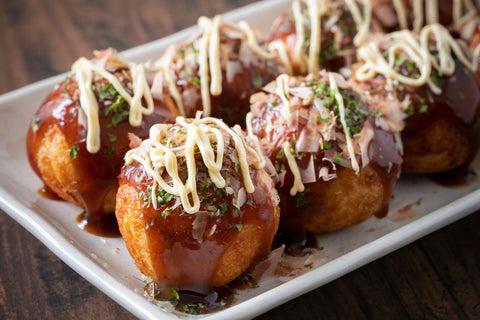
Takoyaki is a ball of wheat flour filled with minced octopus meat and seasoning. It originated in Osaka (1936), when a street food vendor named Tomekichi Endo created the first one. Takoyaki is the size of a golf ball and typically contains tako (octopus), green onion, ginger, and other ingredients coated with a wheat flour-based batter. The wheat batter is then grilled or fried.
Today, you can find it being sold by street food vendors in Tokyo and Osaka. They use a special technique of flipping the takoyaki balls while frying to ensure they maintain their shape. If you buy takoyaki at the stall, it will come with a rich drizzle of takoyaki sauce, katsuobushi (dried bonito flakes), and Japanese mayonnaise. This octopus-filled dough ball is a must-try street food because of its exciting shape and delicious flavor. Enjoy it as a comfort food that will fill you with warmth and satisfaction.
Yakitori: Skewered Perfection Across Japan

The simplicity and variety of yakitori, grilled chicken skewers, make it one of the best street food dishes in Japan. Basically, it consists of seasoned chicken parts on a stick with green onions or scallions between them. The kind of yakitori you get will depend on what chicken parts were used or its preparation method. Below is a list categorizing the most common types of yakitori:
-
Thigh (momo)
-
Breast (mune)
-
Wings (tebasaki)
-
Meatballs (tsukune)
-
Breast and spring onion (negima)
-
Cartilage (nankotsu)
-
Gizzard (sunagimo)
-
Liver (rebā)
Some vendors have menus with several of these types of yakitori available, so feel free to be as adventurous as you like. Yakitori are popular at both Izakaya (Japanese pubs) and Yatai so you shouldn’t have any trouble finding these tasty dishes. When you do get your hands on some, we recommend that you eat it with a bottle of Japanese beer.
Okonomiyaki: Japan's Savory Pancake
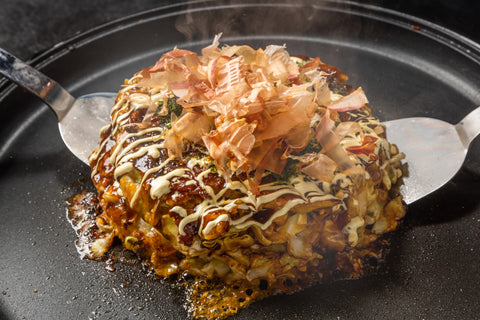
Okonomiyaki, the famous dish nicknamed “Japanese pizza,” is a savory pancake typically made of wheat flour, meat, seafood, and cabbage. Common toppings for okonomiyaki are sauces, seaweed flakes, bonito flakes, pickled ginger, and mayonnaise.
Okonomiyaki has two main regional variations. The first is the Hiroshima-style okonomiyaki (AKA Hiroshima-yaki or Hiroshima-okonomi). For this version, the ingredients are layered and not mixed. Each layer contains cabbage, batter, pork, eggs, and other ingredients. It requires a lot more cabbage to make than the second version, Osaka-style or Kansai-style okonomiyaki, which is more popular. The Osaka version requires mixing and panfrying all of the ingredients. It uses a batter made of grated yam, eggs, dashi, cabbage, and other ingredients.
Other, less common regional variations are served in Tokyo and Kyoto. Outside of Japan, you’ll find street vendors serving the dish in the Philippines, Indonesia, and Thailand. Lastly, remember that okonomiyaki also goes well with Japanese beer, tofu, tomato salad, and deep fried chicken.
Ramen: From Street Stalls to Global Fame
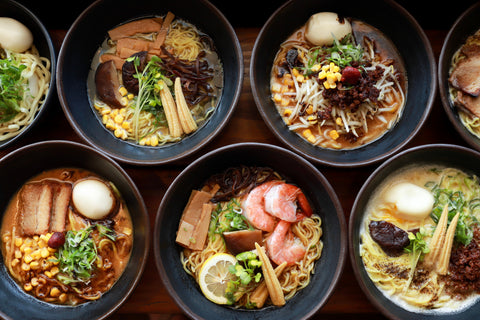
Today, ramen is a global delicacy beloved by people in the United States and Europe. But once upon a time, ramen was nothing more than a humble street food; hence, it continues to grace mobile food stalls on the streets of Japan. Ramen consists of wheat-based noodles immersed in a spicy and savory broth with toppings. Vendors serve it in a variety of ways: from chicken, pork, and beef broths to meat and veggie toppings.
Like okonomiyaki, ramen also had several regional varieties. However, there are a lot more of these variants scattered across the country. We’ll discuss the most common ones below.
-
Tokyo ramen: thin and curly noodles served in a chicken-based dashi broth.
-
Sapporo ramen: umami-rich noodles and broth cooked with miso seasoning.
-
Yokohama ramen: thick and straight noodles served in pork-based broth with soy flavoring.
-
Nagoya ramen: noodles cooked in a super spicy soup.
-
Kitakata ramen: thick and curly noodles with a flat shape served in broth that contains a base of pork and dried fish.
Soba and Udon: Noodles on the Go
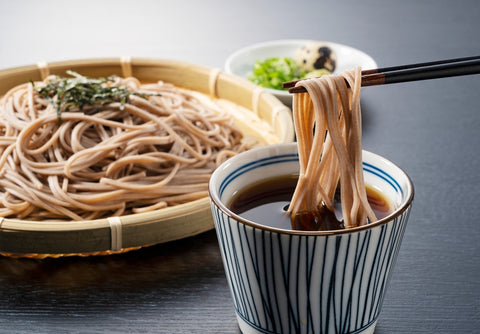
Next, we’ll discuss two other types of noodles that almost rival ramen in terms of popularity: soba and udon. Both have had impressive impacts on Japanese street food culture, however, udon was the first to enter the scene.
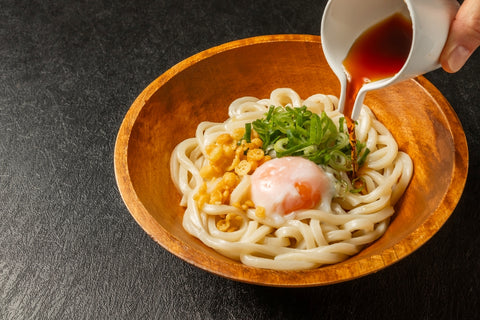
Udon is prepared with wheat flour and it has a thick, chewy texture. Soba, on the other hand, uses buckwheat flour; hence, its texture is a bit grainier than that of udon. Soba also has a darker color than udon. Most street vendors tend to be slightly more conservative with the flavors they use to serve soba because of its nutty taste. With udon, they are a bit more adventurous. The best spots to enjoy these dishes are noodle bars, yatai, and restaurants.
Taiyaki: The Sweet Fish-Shaped Treat
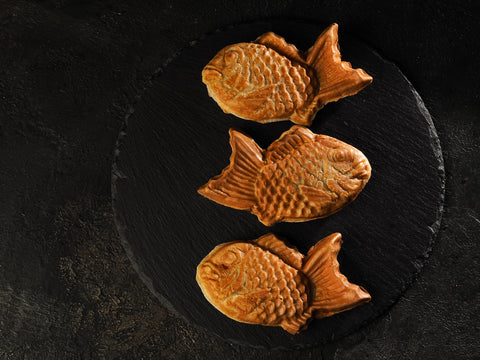 Taiyaki is a Japanese cake typically filled with red bean paste (anko) and shaped to look like a small fish. It can contain other fillings, including chocolate, pineapple, cheese, baked sweet potato, ice cream, or custard. Taiyaki is considered a Japanese street snack because of its popularity on the menus of food stalls and shops across the country.
Taiyaki is a Japanese cake typically filled with red bean paste (anko) and shaped to look like a small fish. It can contain other fillings, including chocolate, pineapple, cheese, baked sweet potato, ice cream, or custard. Taiyaki is considered a Japanese street snack because of its popularity on the menus of food stalls and shops across the country.
The cake is made by pouring pancake batter into a fish-shaped mold before filling and baking it. It is a type of imagawayaki, which is an anko-filled cake that has been around long before 1906, the year taiyaki was invented. According to taiyaki’s origin story, a store owner was desperate to improve sales of his imagawayaki, so he reshaped them to look like fish. It is safe to say that the gimmick worked, and today, millions of people on the streets of Japan are grateful for his insight.
Street Food Innovations: What's New in 2024
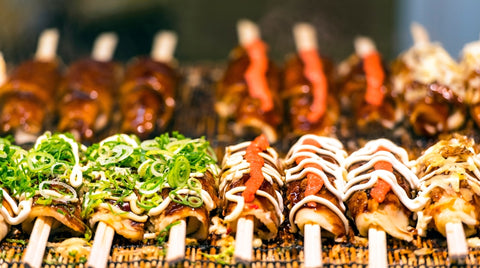
The Japanese street food culture is constantly evolving, and spotting new innovations is the best way to take advantage of these changes. Next, we’ll look ahead to the latest trends and innovations in Japan's street food scene for 2024
Fusion Dishes: Yatai vendors are blending traditional flavors with global recipes to create mouth-watering fusion dishes that are fast becoming favorites among tourists. These dishes are a testament to Japan’s openness to foreign culinary ideas. For example, you can find Japanese dumplings using flavors originating in Mexico or India. Another example is mochi made with French cooking techniques.
Seasonal Fruit Flavors: Filling dessert options like mochi with seasonal fruits instead of red bean paste is also quite common these days. Although the practice has been around for centuries, vendors are becoming more adventurous. Street wagashi (Japanese sweets) are the most affected by the seasonal fruit trend.
Creative Display: Gone are the days when yatai markets were solely focused on filling our bellies. Nowadays, they also try to fill the mind with creative, eye-catching displays. There’s music, story-telling, and fancy cooking techniques - all aimed at engaging the customer.
Plant-Based Options: Another growing trend is the use of plant-based options in street food. Vegetarians and health-conscious people only patronize stalls that cater to their specific need; hence, tofu fillings and dried seaweed snacks are being used as tasty alternatives.
Festival Foods: Seasonal Street Eats

If you’re finding it hard to locate street food varieties, you should consider coming out during certain Japanese festivals or matsuri. One of the wildest festivals in the country is Sanja Matsuri in Asakusa, and it’s the perfect event for enjoying street food. Held to honor the three founders of the Sensō-ji Buddhist temple, Sanja Matsuri is a cultural display of traditions and Japanese cuisine. You’ll find lots of yatai serving dishes like yakitori and dorayaki in the streets closest to the temple. Another festival option is the Kanda Matsuri in Tokyo. This shinto festival attracts ramen and wagashi vendors ready to serve the large crowds of people gathered for the festival. There’s no shortage of street food options during such events.
Dango: A Chewy Treat for All Seasons
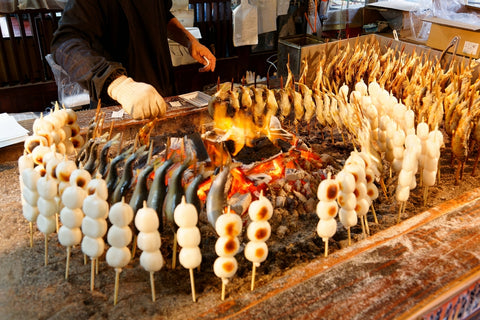
Dango happens to be one of the most popular items on the menus of the wagashi vendors we mentioned above. They are skewered rice dumplings with various flavors and coatings. The main ingredient for making dango is rice flour. It serves as a popular food throughout the year, but with seasonal varieties.
The different types of dango depend on the seasoning used to make the dish, which could be anko, soy sauce, green tea, etc. Two of the most popular types are hanami dango and mitarashi dango. Hanami dango is a traditional Japanese street snack eaten during hanami or cherry blossom viewing festivals in spring. Mitarashi dango is the more general version that’s made with soy sauce, starch, and sugar. It is a year-round favorite that embodies simplicity and satisfaction.
The Art of Street Food Presentation
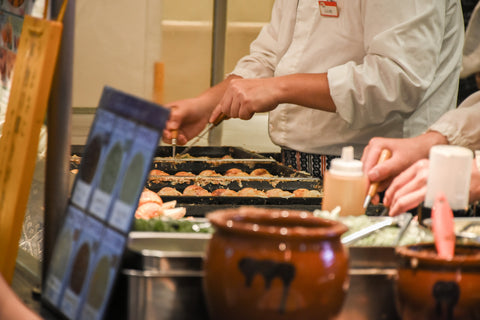
Moritsuke is the art of Japanese food presentation. Grouping and arranging food based on its color, shape, and texture offers several benefits for both the vendor and the customer. The visual appeal makes eating street food more attractive, enhancing the overall experience. Satisfied customers will always come back for more, which helps boost sales for the respective vendors. Many street stalls offer take-out meals in a bento, a traditional lunch box. The most common meals served in these bento boxes are rice and noodles with a variety of toppings.
Navigating Japan's Street Food Alleys

Now that you know enough about street food in Japan, it’s time to learn how to find the best of it by navigating Japan's top street food alleys and markets. The first thing you need to know is where you’re most likely to find these markets. Firstly, you can visit any of two Fukuoka areas: Nakasu or Tenjin. Be sure to try the street ramen in the city. If you’re in Tokyo, head over to Ebisu Yokocho, a street full of food stalls, shops, and izakaya. It’s what some would consider a hidden gem, so you don’t have to worry about overcrowding. Nakano City is another, more populated Tokyo spot with an abundance of street food options. While you’re at any of the yatai, remember to follow these tips:
-
The best time to visit these stalls is after sunset.
-
Keep in mind that there may be limited space at the stalls, and you may have to share tables with strangers.
-
Treat the chef, their staff, and the people in the queue respectfully.
-
Remember to take some cash, as it might come in handy if they don’t offer other payment options.
-
Ask the locals or employees in your hotel for recommendations on the best Yatai spots.
Pairing Street Food with Local Beverages
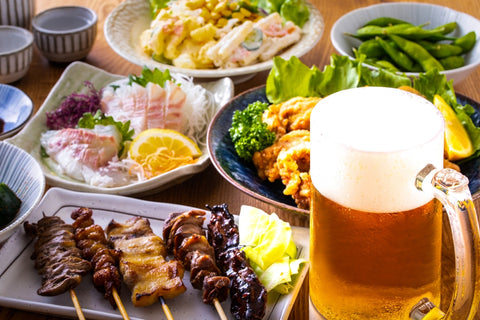
Once you get a hold of some delicious street food, don’t stop there. Enhance the experience by pairing it with the right local beverage. Earlier, we revealed how yakitori pairs well with Japanese beer. What we didn’t reveal, however, is that a rice lager like Asahi Super Dry is the perfect combo. Sweet treats like taiyaki go well with the slightly bitter flavors of green tea. Also, sake, a type of alcoholic rice wine, is one of the most common beverages on the streets. It pairs well with savory snacks, like dango, or fresh seafood, such as sushi. Not sure what drink to get for your meal? Ramune soda is a safe option that pairs well with almost any meal.
The Enduring Charm of Japanese Street Food

The charm and appeal of Japanese street food are here to stay, thanks to places like Fukuoka and Tokyo that make Japan a unique culinary destination. But not everyone can go down to these locations. That is where Bokksu Snack Box comes in. Subscribe today to get a monthly supply of delicious Japanese street snacks, including cakes, cookies, and beverages.
Author Bio







 Bokksu Snack Box
Bokksu Snack Box


























